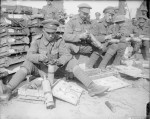CAMERON, John
John Cameron was one of a family of eight boys and one girl, of whom three brothers had died before John Cameron. He gave as his next of kin his sister, Violet May Cameron, living in Vale St. East Melbourne. He himself lived at 46 Hocking St. Footscray, while his elder brother, William, worked for the Footscray Boxing Company, at 360 Collins St., Melbourne. John Cameron was a labourer and, at just under 5' 10", fairly tall for his time.
He enlisted on 28 February, 1916, at Ballarat and was attached to the 39th Battalion. After training, they left Melbourne on the HMAT 'Ascanius' on 27 May, 1916, and landing at Plymouth on 18 July. Once in England, John Cameron was sent to Larkhill for further training and transferred from the 39th Battalion to the 10th Light Trench Mortar Brigade, before proceeding overseas to France on 22 November, 1916. The Trench Mortar Batteries were attached to the Brigades of corresponding number. The 10th Brigade, with the 10th Trench Mortar Battery, was sent to the Western Front nad took part in the major battles there.
John Cameron remained with the 10th L.T.M.B. until 3 March, 1917, when he was admitted sick to hospital in the field, with dermatitus and seborrhea. he was released to duty on 30 March and rejoined his unit in the field, but was re-admitted the next day with excema. Again he was treated and released, but on 12 April, he was sent back to hospital with bronchitis and placed in hospital at Boulogne.
On 24 May, he returned again to his unit, rejoining them near Armentieres on 1 June, 1917. The next day, he was wounded while on duty and admitted to the 9th Field Ambulance Station, where the officer in commmand reported: 'Pte. Cameron was admitted to the Main Dressing Station of this unit on 1 June, 1917, suffering from a severe wound of the thigh and died at the dressing station at 3,30 the same day.' The Court Inquiry into his death reported that he died of wounds received accidentally owing to the explosion of Stokes' Shells in an ammunition dump at Hyde Park Corner, Ploegsteert Wood and that no blame attached to him, as he was on duty at the time. Hyde Park Corner was a road junction to the north of Ploegsteert Wood, on the outer of the Ypres salient.
A further entry directs that the original complete entry be deleted and in lieu, his entry should read 'Died of wounds received accidentally', with no further detail. Stokes' Mortars were invented by Sir William Stokes. They could fire as many as 25 shells per minute and were in wide use in the latter half of World War 1. by the end of the war, the British Forces had 1,636 of them in use. One potential problem, however, was that as the mortar was only three times as heavy as the ammunition, instead of 100 times as in larger guns, the recoil was particularly severe, and if the mortar legs were not positioned correctly, it could fall over backwards with severe injuries to those handling it.
John Cameron was buried at Pont D'Achelles Cemetery, Row A, Plot 1, 2 miles north-east of Steenwerck and 3 miles north-west of Armentieres. He was thirty years old. He is remembered in the AWM145 Roll of Honour Cards and on Panel 19 in the Commemorative Area. His sister, May, nominated as his next of kin, received a war pension of one pound per fortnight.
Australian War Museum, Canberra, Embarkation Record, Unit Histories
Australian National Archives, Srvice Record
Wikipaedia Stokes' Mortars, photograph of soldiers with Stokes Mortars 1917
Ancestry.com.au Births, Deaths and Marriages

